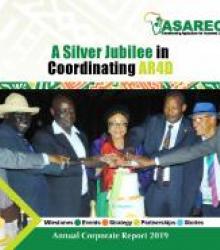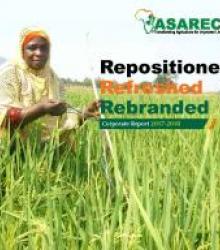| Title | Author | Asbract |
|---|---|---|
| Why the low adoption of agricultural technologies in Eastern and Central Africa? | ASARECA | Agriculture is arguably the most important vehicle for realising economic development, creating employment and reducing poverty in Africa. In the Eastern and Central Africa (ECA) sub-region, agriculture accounts for about 43% of the gross domestic product (GDP) and over 60% of exports. About 70% of the population and nearly 90% of the poor work in agriculture where they depend on increased agricultural productivity to lift them out of poverty. |
| Best-bet technologies for addressing climate change and variability in Eastern and Central Africa | ASARECA | Kimenye L, ed. 2014. This publication contains of information on technologies and innovation for addressing climate change and variability in Eastern and Central Africa. They were compiled from national agricultural research system (NARS) and International research centers working in the ASARECA region. The information was submitted and discussed at a regional conference on Climate Change Adaptation Strategies, Capacity Building and Agricultural Innovations to Improve Livelihoods in Eastern and Central Africa Post-Copenhagen (UNFCCC/COP151) in Addis Ababa, Ethiopia, 7ÔÇô9 June 2010. |
| Scaling up Dissemination and Adoption of Agricultural Technologies using Innovation Platforms Lessons from Eastern and Central Africa | ASARECA | Between 2008 and 2013 ASARECA coordinated and provided leadership in implementing a project called Dissemination of New Agricultural Technologies in Africa (DONATA) across 6 countries in eastern and central Africa. The approach in DONATA was the innovation platform for technology adoption (IPTA). At the start of the project, there were limited documented practical experiences and lessons from which to draw guidance for the implementing teams comprised of national agricultural research systems (NARS). Therefore, an inherent objective in the project was to document achievements, experiences and lessons learned on how the IPTA approach was used to disseminate technologies on orange-fleshed sweet potato (OFSP) and quality protein maize (QPM). The DONATA experiences, the synthesis of lessons and guiding principles presented in this book are therefore a contribution to the growing body of knowledge on the application of innovation platforms and value chain framework in agricultural research for development in the region. The information shows how the DONATA project teams used the AIS theoretical concepts to establish and manage innovation platforms to disseminate and scale out OFSP and QPM technologies. ASARECA envisages that stakeholders within the region will find the book useful in their efforts to increase the spread and impact of science and technology in smallholder agriculture. |
| ASARECA Strategy for Scaling Up Agricultural Technologies and Innovations: 2014 - 2018 | ASARECA | KRA 1: Access to knowledge and information facilitated. This is about the processes and practices concerned with acquisition, archiving and sharing of knowledge. It is an integral part of the agricultural knowledge and information hub to be established in the implementation of OP2. KRA 2: Emergence of new agribusinesses facilitated. This result area is about research activities that can deliver value chain products and innovations (product development), and nurture the resulting products into fully-fledged agribusinesses. The mechanisms include agribusiness incubation by which a product or innovation from a research process is assessed for suitability and adapted for commercialization. KRA 3: Partnerships with scaling up service providing institutions enhanced. This output recognizes that dissemination of information and scaling up of technologies are complex and in some cases specialized processes which ASARECA cannot undertake alone. Potential partners include: non-governmental organisations (NGOs); actors in commodity agribusiness value chains; seed value chain actors; and the African Forum for Agricultural Advisory Services (AFAAS). KRA 4: Capacity for enabling environment and skills for scaling up enhanced. This result area deals with improving capacity of NARS, particularly the less resourced ones, for technology adoption and scaling up. It includes development of methods and approaches for scaling up and using them to enhance capacity of NARS in scaling up. KRA 5: Efficient market linkages between farmers and agribusinesses fostered. The focus here is to use innovative technologies including information and communication technology (ICT) tools and methods to provide producers, especially small-scale farmers with real-time market information and to link them to markets. The strategy borrows experiences from India, which show that provision of market information can greatly assist such farmers to choose what commodities to produce, what production technologies to apply, when to produce, and indeed for whom to produce. In other words, for smallholder farmers to change their situation and improve their livelihoods, provision of market information to them will be key to their transformation.
|
| Africa Agriculture Status Report 2018: Catalysing Government Capacity to Drive Agricultural Transformation | Alliance for a Green Revolution in Africa | This book was launched during the African Green Revolution Forum (AGRF), which took place from September 5th _ 8th in Kigali, Rwanda. The report aims to shed light on what governments could do and to highlight that strengthening government capacity is critical to implementing agricultural transformation. The report clarifies that implementing agricultural transformation would occur in many places, not only across different ministries and government agencies, but also at many points within the private sector. The report addresses how to strengthen government capacity to implement agricultural projects at each of these points. It emphasizes mutual accountability, recognizing that holding all stakeholders including governments accountable to the progress of implementation and delivery is central to agriculture sector performance. This report looks into ways of translating visions into reality; how political leaders can buy-in to what they are trying achieve; how to plan and align resources; and how to manage the various obstacles, distractions and challenges that derail laid out plans. It also looks at how one can create the right conditions and set out a clear and coherent policy framework, which enables the private sector, supports smallholder farmers, and builds a coalition with civil society and development partners. The report serves as a handbook for Governments and their supporting partners to help them transform agriculture, and economic transformation more broadly, in Africa. |
| OPI Impacts | ASARECA | The report presents findings of the NRI/AfrII Impact Evaluation of the Association for Strengthening. Agricultural Research in Eastern and Central Africa (ASARECA)’s First Operational Plan (OP1) 2008-2013. |
| Annual report 2012 | ASARECA | |
| ASARECA Annual report 2011 | ASARECA | Pooling regional resources to feed populations: Story titles of highlights of progress made in 2011 include:- Nine drought tolerance genes for maize; Pen-side diagnostic kit for Taenia solium ready for validation; Fifty six (56) striga resistant sorghum lines move towards release; Conserving cassava and sweet potato germplasm for posterity; Vegetables with potential to boost household income and nutrition; Empowering farmers to process fruits for better earnings; Study refutes misconceptions about drylands; Strategies for adapting to climate change; First General Assembly and Getting African information online |
| ASARECA Annual Report 2008 | ASARECA | The year 2008 was a successful year in terms of consolidating the positive changes being made in ASARECA towards realizing the vision of making ASARECA a ÔÇ£regional leader in agricultural research and development for improved livelihoods in eastern and central Africa.ÔÇØThe governance structure of ASARECA was changed to expand the Board of Directors and include members representing various stakeholders; work on the Constitution and Governance Manual progressed well; and changes in the management of research for development were also complete. All the seven programme managers were recruited but three of them would report early in the following year. In addition, various new organs became functional. |
| ASARECA Annual report 2009 | ASARECA | Theme for Annual report 2009: Generating and scaling out agricultural technologies and innovations for improved livelihoods. 2009 was the year when most of the change processes initiated in 2006 and implemented through to 2008, were completed by ASARECA. |
| ASARECA Annual Report 2007 | ASARECA | The ASARECA Annual Report for the Year 2007. The year when the decision was made to transform ASARECA from its original form and function, to a new form and a new function. |
| ANNUAL REPORT 2010: Technologies without borders: Sharing regional innovations for food security. | ASARECA | he focus of ASARECA has been to increase the efficiency of agricultural research in eastern and central Africa to facilitate economic growth, food security and export competitiveness through productive and sustainable agriculture. |
| ASARECA Annual Report 2014 | ASARECA | To all our esteemed partners and colleagues, let celebrate! ASARECA is 20. Yes, this year2014, ASARECA made 20 years since itwas established in September 1994. The year is also unique in other ways: It marks the first year of ASARECA Second Operational Plan (2014 - 2018) following the successful completion of the 1st Operational Plan (2009-2013). These two plans are based on the 10-year Strategic Plan (2007-2016), which ASARECA is using as a long term direction for research for development interventions in the sub-region. |
| Annual Corporate Report 2016 | ASARECA | ASARECA is strategically repositioned to perform a higher level role to enhance sustainable agricultural transformation, economic growth and inclusive development in the Eastern and Central Africa (ECA) sub-region. A repositioned ASARECA is poised to provide leadership as a premier intermediary and interlocutor for research, public, private and civil society organizations to facilitate collaboration in specific AR4D initiatives. This means avoiding duplication, but instead nurture and coordinate effective partnerships to exploit synergies, create a more enabling policy and investment environment, and mobilise resources to invest in AR4D in the ECA sub-region. Niche of the repositioned ASARECA facilitative coordination convening supportive advocacy |
| ASARECA @25: Celebrating decades of Coordinating Collaborative Agricultural Research for Development (1994-2019). Abridged Version | ASARECA | The Association for Strengthening Agricultural Research in Eastern and Central Africa (ASARECA) is a not-for-profit inter-governmental sub-regional organization. ASARECA comprises 12 member countries: Burundi, the Democratic Republic of Congo, Eritrea, Ethiopia, Kenya, Madagascar, Republic of the Congo, Rwanda, South Sudan, Sudan, Tanzania and Uganda.ASARECA was established in 1994 by ten member States represented by their National Agricultural Research Institutes (NARIs) following the approval of the Framework For Action (FFA) for agricultural research in Eastern and Central Africa by the Special Programme for Africa Agricultural Research (SPAAR). The original ten member States included Burundi, Democratic Republic of Congo, Eritrea, Ethiopia, Kenya, Madagascar, Rwanda, Sudan, Tanzania and Uganda. The membership has since grown to 12 following the admission of South Sudan and Republic of the Congo in 2011 and 2019 respectively |
Search
Search entail eLibrary collection
Copyright © 2025. All rights reserved.
Designed By ASARECA


